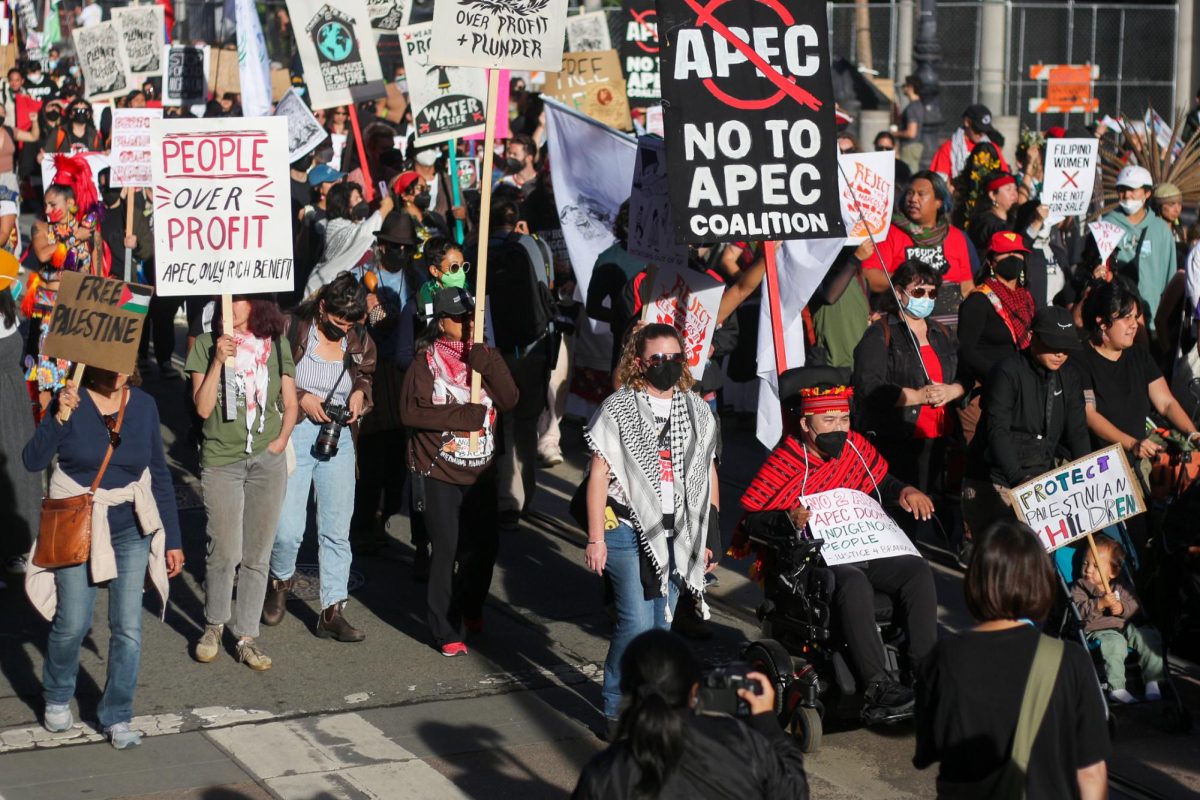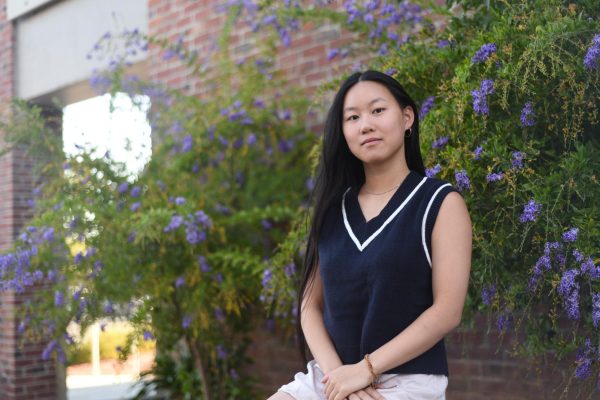“No to APEC! People over profit!”
Demonstrators’ chants filled the streets of San Francisco as thousands marched on Market St. from Harry Bridges Plaza to the Moscone Center on Sunday, Nov. 11, in protest of the Asia-Pacific Economic Cooperation (APEC) convention.
Homelessness has historically been a large issue in San Francisco, beginning in the 1980s, and remains an ongoing challenge. The city of San Francisco spent weeks cleaning the streets, implementing roadblocks, devising city zones and moving the homeless off the roads and into shelters. Protestor Kristina Lee highlights how this leaves the root cause unaddressed.
“I am very frustrated that the city is very good at moving the homeless people out of view of people who are powerful,” Lee said. “We see this with APEC, we see this whenever there are big events that San Francisco wants to show off. They find ways to hide the homeless people away from the view of the nation, even though everybody knows that this is an ongoing problem.”

Many protestors expressed shared concern about the removal of homeless people from the streets in preparation for the historic event. Initially established in 1989, the forum was created as a platform to “advance sustainable and inclusive economic growth” among Pacific Rim economies. Key initiatives include economic deregulation, free trade agreements and reducing impediments to commerce.
World leaders from over 20 countries — including President Joe Biden and Chinese President Xi Jinping — met at the Moscone Center to discuss economic policies in the Asia-Pacific region. Ending on Nov. 17, the APEC Economic Leaders’ Week meeting marked the conclusion of U.S. APEC 2023.
Prior to Biden’s arrival, the demonstrators took to the streets to protest a variety of issues — worker’s rights, lack of climate action, U.S. funding of Israel and more, waving posters and banners highlighting their causes under the overall theme of fighting against imperialism and what they see as the global leaders’ oppression of its people.
“One: we are the people, two: a little bit louder, three: we want justice for all workers!”
Numerous organizations, including Lee’s Freedom Socialist Party, attended the protests organized and led by the No to APEC coalition. Lee handed out flyers to protestors amid the demonstration, titled “No to APEC, yes to global worker solidarity!” She says that although the convention marks “global leaders actively organizing against the global working class,” the true power lies in the hands of the united demonstrators.
“The main thing that I’m hoping for is for there to be more connections,” Lee said. “The No to APEC coalition had a convention yesterday, where we all got to really meet and educate one another about the struggles that we are all facing due to global capitalism. And by putting all of those struggles together we see that we’ve got so much in common and that we need to fight together, and I’m hoping that those are things that we all remember, so that we can continue the struggle because we’re not going anywhere without this unity.”
Stanford University senior Thomas Mansfield chose to participate in the march, having also joined a recent sit-in for Palestine staged by students at Stanford. While Mansfield, who grew up on the East Coast, feels that his lack of connection to California initially made it difficult for him to get involved in local activism, he states that the amount of people at the APEC protests encouraged him.

“Seeing other people out here and being inspired has also pushed me to get out here as well,” Mansfield said. “The main form of protest really is education, just learning about what’s happening with APEC. This is not something that many people know about at all. Once you start to learn more about the things going on in the world, that’s what really drives you to get out there and moving.”
Likewise, Maria Rodriguez, a member of an organization for local workers and mother of two, brought her children, aged 10 and 12, to the protests to educate them on these pressing issues and teach them to be “a part of the solution” rather than the problem. Rodriguez has been a part of the labor movement since 2005, hoping to send a message to the government and those involved in APEC.
“Why, knowing that we have a bigger problem, do they come here thinking that everything is fine?” Rodgriguez said. “People are dying for no reason, and we got to put a stop to that. That’s the problem. It’s telling them that we’re not going to stand behind it, we’re going to defund whatever cooperation you guys are part of and we’re going to bring you guys down.”
Meanwhile, with their family coming from Bangladesh, International Migrants Alliance member Naz says the exploitation of Bangladeshi migrant workers, as well as corporations and powerful elites profiting from their land, is a “tale as old as time.” Naz believes this story is one that connects them with migrant workers around the world, inspiring them to take part in the Nov. 11 march. To Naz, APEC is a ruse for this exploitation.
“They will accept our labor, but they won’t accept our humanity,” Naz said. “And that’s a story that we keep hearing all around.”
“When people’s rights are under attack, what do we do? Stand up, fight back!”
Likewise, Mansfield believes the APEC initiatives are “economically not feasible and exploitative at their core.” One of Mansfield’s main concerns is the exploitation of workers that results from deregulation — many protestors marched with slogans like “People + planet over profit + plunder,” decrying the prioritization of corporate profit over climate action and worker’s rights.
“Instead of pushing for this deregulation, I think that we should be pushing for the opposite,” Mansfield said. “We should be working more towards regulation that is constructive, and is actually helpful to ensuring that workers have rights and people have rights in the environment.”
Naz echoes Mansfield’s argument that in reality, the trade deals and policies made at conferences like APEC are geared towards bringing in profit for corporations, disregarding the fact that the workers propping up these companies will receive none of the benefits of their labor. Overall, Naz is adamant that the protestors “see right through it — all of [us] and our families in these cities, where we have had to move from our home countries, bear witness to the exploitation.”
“I think everyone already cares about it in some way or other,” Naz said. “The struggles that we have in our neighborhoods, in our own homes — from our mothers not being able to afford their medication, to our fathers having to work 16 to 20 hours a day, to our neighborhoods not having enough funding for their schools — are interconnected to corporate greed. You can see from today, thousands of people gathering because they’re realizing that all the things that we care about, all the hurt that we‘re experiencing, are all connected.”
















